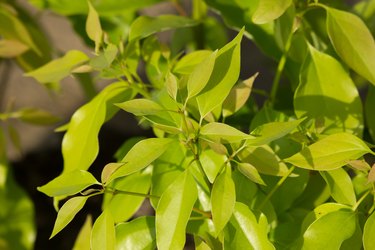The camphor tree (Cinnamomum camphora, USDA zones 9-11) is a fast-growing favorite for gardeners. Its leaves and berry-like seeds have numerous beneficial properties. However, if the medicinal scent of camphor doesn't appeal to you, this may not be the tree for you.

The camphor tree has an aroma that can be off-putting to some and a favorite for others. The strong menthol fragrance comes from the bark of the camphor tree. To pull the waxy substance that is used to make camphor oil from the bark of a camphor tree, the tree has to be a minimum of 50 years old. Its berries and leaves are used for simple ailments, from itching to reducing inflammation.
Video of the Day
Video of the Day
Growing Camphor Trees
A camphor tree can live for 50 to more than 150 years, with a thick, sturdy trunk. This is mostly dependent on the soil and water conditions. Camphor trees prefer to grow in fertile, sandy soil. They like a pH level of around 4.3 and 8 but no higher. The rounded canopy of the camphor enjoys a lot of sun.
The camphor tree needs a lot of space to grow. It will quickly take up space with a rounded canopy that needs room to stretch and expand. Reaching a mature height around 60 feet, the camphor tree has an enviable canopy that spreads out to an approximate equal width of 60 feet at its capped crown.
How to Identify a Camphor Tree
Its scientific name is Cinnamomum camphora. It is within the Lauraceae family. The invasive species is native to north and central Florida and the humid hills of Japan and China. It may be related to the cinnamon tree, but the camphor has a scent that people either love or love to hate.
If you aren't sure if the tree you have in your yard is a camphor tree, there's a quick solution. Simply crush the leaves and take a whiff. The camphor is highly fragrant and will release a cloud of medicinal aroma when its leaves are crumpled.
Uses for Camphor Leaves
When leaves first shoot from the slender branches of the camphor tree, they are ideal for being made into a medicinal remedy. Boil young leaves and either drink this tea or eat the leaves to relieve muscle aches and headaches.
The roots of a camphor tree can be dug up, cleaned and boiled for a refreshing tea. The leaves may also be boiled and applied to rashes or to relive pain from itching. Some have applied boiled leaves to treat cold sores, warts and hemorrhoids.
Camphor Tree Berries
The camphor tree is a litter bug. It will drop thousands of fragrant laurel berries on the ground under the full, wide canopy of the tree. The camphor berries are shiny and black and a favorite for birds, who are a big help in spreading the tree's seeds.
These berries will let their seeds loose quickly. If you don't want to grow more camphor trees, it's a good idea to gather up the berries.
Soil for Camphor Trees
Camphor trees enjoy a nice, wet soil. Because these trees prefer high humidity in the places where they're planted, they need a soil that is a mix of sand, loam and clay. Soil pH should be slightly acidic to highly alkaline.
Camphor Tree Problems
While hardy and fast growing, the camphor tree is susceptible to a few pests and problems that can stunt its growth, including:
- Root rot
- Verticillium
- Anthracnose
- Armillaria
- Phytophthora
This globally known tree has many names. It is also called:
- True camphor
- Kampfer
- Japanese camphor
- Honsho
- Alcanfor
- Laurier du Japon